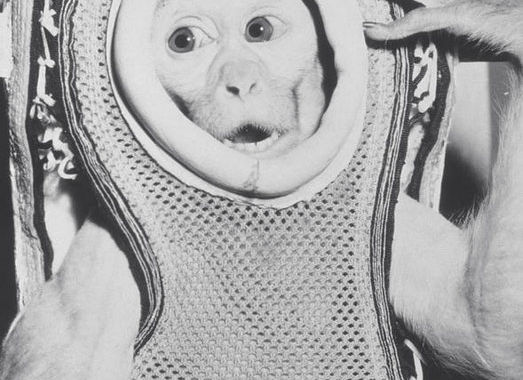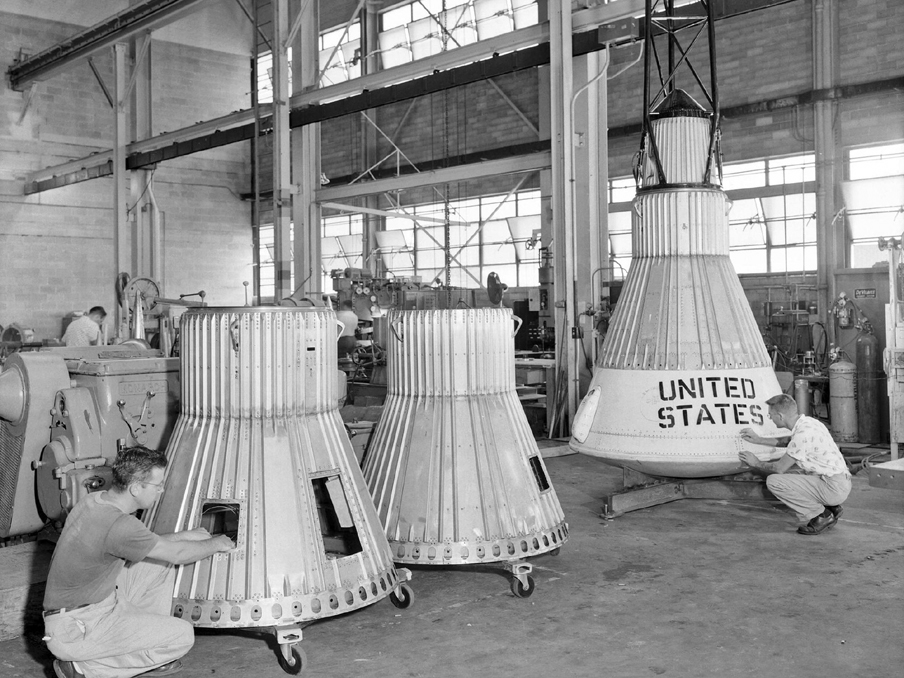
-
This is Sam. He lived in America.
-
He was very happy. But he had one fault. He was too curious.NASA
-
One day Sam saw a man. The man saw Sam, too.NASA
-
"What a nice little monkey," the man thought. "I would like to take him to space."NASA
-
The man picked him up quickly and popped him into a bag.NASA
-
On the big ship, things began to happen. (This is a Little Joe rocket with a boilerplate Mercury capsule on top, which can be seen today in a park near Wallops Island).NASA
Sam the rhesus monkey had already experienced one hell of a ride to the edge of space when he splashed down into the Atlantic Ocean—but his adventure didn’t end there. Although the dry, original accounts of Sam's 1959 flight offer scant detail about the journey, mainly confirming that NASA’s new Mercury capsule kept him alive, Bob Thompson tells a more colorful story.
Now in his early 90s, Thompson can still dominate a room with his commanding voice. And on a recent January morning, standing in his kitchen, Thompson did just that as he recounted the landing of Sam nearly six decades ago. In doing so, he offered a parable for NASA as it considers rescue operations for its Orion spacecraft at sea.
Back in December 1959, NASA was 18 months away from Alan Shepard’s flight into space. The agency still had rockets and spacecraft to test. And scientists knew almost nothing about the effect of weightlessness on humans or how to keep them alive. More immediately, they wondered about the safety of a new launch-abort system, needed to get the crew capsule quickly away from the rocket in case of an accident. Rockets blew up a lot back then.
So when NASA's young engineers at Langley Research Center in Virginia began testing their new Mercury capsule in flight, they wanted to see whether the accelerations experienced during the abort of a Mercury flight shortly after launch were survivable. Enter Sam, an eight-pound rhesus monkey.
It was up to Thompson to recover Sam, or what remained of him, after the test flight. An original member of NASA’s Space Task Group, Thompson had been brought in a year earlier to head up landing and recovery operations for NASA and coordinate with the US Navy. Rough seas had scuttled attempts to launch Sam earlier in the week. But finally, by December 4, the seas had calmed—a little.
“I was out there on a destroyer, and there were 20-foot seas,” Thompson recalled. “The destroyer captain was an ex-submarine guy. I stayed on the bridge, and I set him on a course with the wind and the seas that favored recovery. And I said, 'Stay steady as you go and don’t stop.' Then I left the bridge and went down to the deck to help them get the capsule out of the water."
The flight
By then Sam had already had quite a ride. Housed inside a 36-inch by 18-inch container within the capsule, Sam had been launched atop a Little Joe rocket. At one minute into the flight, traveling at 3,685mph, the Mercury capsule’s abort system fired. In his contour couch, Sam experienced 10 to 12Gs before a little more than three minutes of weightlessness, reaching a peak altitude of about 53 miles. The capsule’s pressure fell from 1 atmosphere to about half of that during the flight.
And then the Mercury capsule fell into the turbulent seas off the Virginia coast, bouncing around and waiting for Thompson and the Navy to come and pick him up. Eventually, the ship tracked Sam's capsule down.
As Thompson watched, deckhands worked with a long aluminum rod that had a hook on the end. With the ship and capsule swaying back and forth, the goal was to hook the rod into an improvised latch on top of the Mercury capsule, which looked something like the handle of an Easter basket. But then, just as the capsule was hooked, the captain stopped the ship.
A wrecking ball
“So the ship is really rolling, and the capsule is out there like a wrecking ball,” Thompson recalled.
"And then, all of a sudden, BAM!
"It's thrown up against the side of the ship.
"It goes back out and BAM! Up against the side of the ship again.
"I’m down there on the deck and after the second BAM! I told the coxswain to loose the line. Then the thing hit again and got hung up on the deck. We threw a lasso around it and washed a sailor overboard in the process.” (He was later recovered).

Surprisingly, the capsule wasn’t damaged much. But what of Sam, who had flown to the edge of space and then been tossed and crashed around back on Earth?
“The monkey was inside in a large aluminum can, which was bolted down. We took the top off, and I crooked my finger and put it down in there. He took a hold of it. So we got some [diagonal wire cutters] to cut him out of his contour couch. I set him down and told the chief petty officer to go get some apples and oranges. The monkey was hungry. He ate up most of the oranges.”
After the flight, an analysis of electrocardiogram, respiration, body temperature, eye movements, and other measurements showed no abnormal results from Sam's physiological and psychological reactions. He'd survived the ordeal, appetite intact. Sam, who had come from the US Air Force School of Aviation Medicine at Brooks Air Force Base in Texas, returned home. He lived a long life, dying in 1982, when his remains were cremated.
"space" - Google News
December 01, 2019 at 08:20PM
https://ift.tt/2ODAxwU
That time a monkey flew to the edge of space and then smashed into a destroyer - Ars Technica
"space" - Google News
https://ift.tt/2Q8TIzF
Shoes Man Tutorial
Pos News Update
Meme Update
Korean Entertainment News
Japan News Update
Bagikan Berita Ini















0 Response to "That time a monkey flew to the edge of space and then smashed into a destroyer - Ars Technica"
Post a Comment